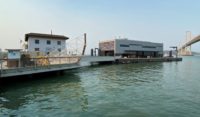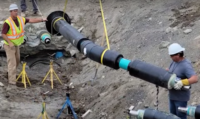The first floating data center built for Nautilus Data Technologies is getting a second-phase expansion in Stockton, Calif., while the firm accelerates plans for it and Bechtel to engineer and construct others in Maine and possibly Ireland.
The multi-year program allows Nautilus to deploy its water-based system for sustainable and efficient data center cooling, while Bechtel focuses on development and construction. "There is no way we could scale without [the contractor]." says Rob Pfleging, president of Nautilus Data Technologies.
Nautilus completed the floating 7-MW scalable Stockton 1 Data Center, located on a barge on the San Joaquin River, last year before it signed an agreement in June with Bechtel. The two now are building a 10-MW center in Millinocket, Maine, targeted for a December 2022 opening. The firms are "very interested" in an Ireland project and are working through possibilities elsewhere around the globe.
Costs for the California, Maine and Ireland projects were not made available. Media reports say the Maine facility is a $300-million project. and the Limerick, Ireland, center is estimated at $35 million.
"We would like to build as many of these together as we can," says Peter Nelson, managing director for infrastructure at Bechtel Enterprises. "We have a development and delivery partnership, helping to scout and develop sites. We are involved from conceptional engineering right through to delivering [the project.]"
Not all The Nautilus data centers float, with some using a nearby fresh or saltwater body for water cooling.
Traditional processes to cool data centers include multiple heat transfers, coils, cooling towers and chilled water. In the Nautilus system, a coil directly on the back of the data rack collects heat, which is sent through two water exchange systems that do not use chemical refrigerants.
The first is a closed-loop system of 100% pure water, moved through the loop in a light vacuum. If failure occurs, the vacuum sucks air into the system instead of pushing water into the center. "There are no leaks under vacuum," Pfleging says, with added benefit that water does not require treatment. "Nothing can grow in the low-oxygen environment," he says.
Water is then sent from the nearby water body to a heat exchanger for processing and discharged—a 15- to 16-second process that adds between 1 and 4° F to the water temperature, according to Nautilus. By comparison, power plants typically are permitted to add 20°.
Both loops communicate in what Pfleging describes as a "harmonious dance to make sure we optimize efficiency within the data center space."
He adds that the process "is a flavor of geothermal, but we've really applied a lot of interesting tech so the data center community is comfortable, and the coding we've written is able to fine-tune for the environments we sit in.”
The average power utilization effectiveness (PUE) for data centers is 1.59 watts for every watt of power used processing on the server. The Stockton facility will come in at 1.15 PUE. The Maine facility, which will drop to 1.1 PUE, will use 100% hydroelectricity, with water outflow set to support an aquafarm that prefers prefiltered warmer water for its operation. Other committed clients include Jackson Laboratory and Maine Chamber of Commerce.
The Stockton system uses modular units that cost the same or less to build than a traditional facility, while meeting standards such as the California Environment Quality Act, various federal fish and wildlife requirements and water quality requirements as part of the permitting process, Nautilus says.
Approaching construction of a data center as an industrial ptoject instead of as a commercial building was part of the draw for Bechtel, Nelson says.
The combination of an environmentally friendly system with superior technical performance and a cheaper price structure means the partnership can compete in a global data center market focused on time to market and cost, he says.






Post a comment to this article
Report Abusive Comment